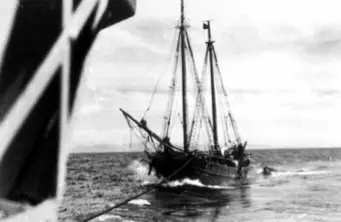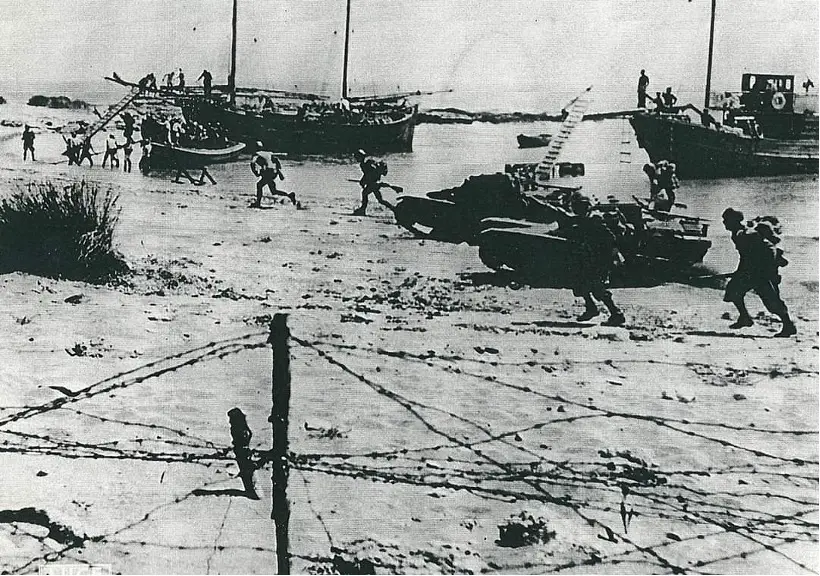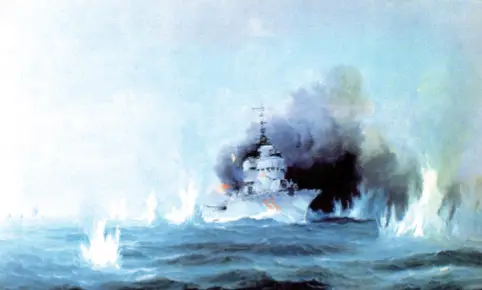The Battle of Crete was a bloody military affair that saw on one side the massive deployment of German airborne troops and fierce resistance from British land and naval forces on the other side. However, it is often overlooked that Italian forces too participated in Operation “Merkur”.
Planning the invasion
The decision to invade Crete was taken in late April 1941, when Hitler tasked Goring and the Luftwaffe to capture the island in the fastest way possible, thus securing his southern flank before the start of Operation Barbarossa.
German plans did not involve the Italian forces, except for the reliance on the limited naval forces available in the Aegean, comprising a few torpedo boats and destroyers and M.A.S. boats. However, the naval aspect of the invasion was not certainly secondary. If the paratroopers in the first wave were meant to capture the airfields to facilitate the arrival by air transport of the German mountain troops, these forces had then the mission to capture anchorages, like Souda Bay, to allow the arrival of seaborne reinforcements and the heavy equipment.
The German navy commanders showed some scepticism regarding this bold plan conceived by the Luftwaffe but nevertheless complied with the plan requirements, hastily assembling a heterogeneous array of boats and caiques destined to transport troops and supplies to Crete.
The Italians remained unaware of the details of the planned invasion and only in mid-May did the Germans approach the Italian Navy to discuss the potential intervention of the fleet. Admiral Arturo Riccardi, chief of staff of the Italian navy, replied that in principle the fleet was available to intervene. However, he stressed that at the moment, the Mediterranean fleet could field 4 battleships armed with 15-inch guns while the Italians had only one (the Littorio), plus the rebuilt dreadnoughts Doria and Cesare mounting the 12.6-inch guns. The Duilio had rejoined the fleet after repairing the damage suffered in the Taranto raid but was still not fully operational. In addition, the Italian destroyers were already overstretched in their service duties, and supporting the landing operations in Crete would have meant the suspension of all the convoys to Libya, in a moment when Rommel was recapturing Cyrenaica. Last but not least, the losses incurred in such an unfavourable fight, would have heavily weakened (in Riccardi’s opinion) the ability of the Regia Marina to sustain a prolonged war in the Mediterranean.
These considerations, coupled with the fact that the details of the German plan were still unclear to the Italians, one week before the beginning of the Operation, help us to understand why the Italian battle fleet was not committed to the action.
The action of the Lupo
The battle of Crete began on the 20th of May 1941, with a heavy aerial bombardment of the Allied positions and the first airdrops of German paratroopers. The Mediterranean fleet was patrolling against seaborne landing forces with cruisers and destroyers, while the fleet core, with Admiral Cunningham’s battleship, was patrolling southwest of Crete in case of any unpleasant sortie of the Italian fleet.
The battle of Crete began on the 20th of May 1941, with a heavy aerial bombardment of the Allied positions and the first airdrops of German paratroopers. The Mediterranean fleet was patrolling against seaborne landing forces with cruisers and destroyers, while the fleet core, with Admiral Cunningham’s battleship, was patrolling southwest of Crete in case of any unpleasant sortie of the Italian fleet.
In the night between the 21st and 22nd of May 1941 the torpedo boat Lupo, commanded by Captain Francesco Mimbelli was escorting a group of 21 caiques transporting German troops destined to land on the shores of Crete, in the Maleme area.
At 22:33 the convoy sighted a ship steaming eastwards and crossing its route. The vessel sighted was the destroyer HMS Janus, part of Rear-Admiral Glennie’s squadron comprising the Cruisers Orion, Dido, Ajax, and the destroyers Hereward Hasty and Kimberley. Lupo sighted the larger British formation a few minutes later.

Figure 1 A paint from Rudold Claudus depicting the night action of the Lupo
Figure 1 A paint from Rudold Claudus depicting the night action of the Lupo
Realizing the dire situation, Captain Mimbelli signalled the caiques to invert their course and sail back to Greece while he attempted an audacious attack against the British formation to save the convoy. The Lupo sailed straight towards the enemy formation and then turned to port to launch two torpedoes on the starboard side. In the meantime, the British guns had opened fire against the charging Lupo.
The attack of the torpedo boat surely caught Glennie’s formation by surprise and caused disorientation among the British formation, which also incurred in friendly fire accidents. A few seconds after the torpedo launch, the crew of the Lupo sighted a large column of water on the side of a British cruiser, probably the Orion (1). Amid the confusion, the Lupo managed to cross the British squadron, inflicting minor damages but also suffering 18 hits, 2 dead, and 26 wounded. Benefitting from the temporary disarray of Glennie’s formation, the Lupo managed to retreat.
In the course of the night, the British ships managed to intercept some of the caiques, sinking 7 of them and killing 297 Germans and 7 Italians. Hours later the Lupo came back to the site of the battle to save the survivors. For his action, Captain Mimbelli was awarded the Gold Medal for Military Valor while Lupo’s battle flag was decorated with the silver medal.
The action of the Sagittario
A second and larger convoy carrying German troops to Crete was en route on the night of the 22nd of May, but after the action of the Lupo, the German naval command recalled the convoy back. The formation consisted of 38 caiques escorted by the torpedo boat Sagittario, commanded by Captain Giuseppe Cigala Fulgosi.

Figure 2 A German sailor signaling to the Sagittario (AUSMM)
At 8.35 the convoy was sailing back when the Sagittario sighted British ships to the south, these were the cruisers Naiad, Calcutta, Perth, and Carlisle with the destroyers Kingston, Kandahar, and Nubian. Captain Cigala Fulgosi had begun laying a dense smoke screen to hide the retreating and slow-moving convoy.
At 9:01 the British formation, commanded by Admiral King, sighted the enemy and opened fire. The Sagittario became surrounded by the shell splashes and charged the British line firing with the forward 100mm gun. With the distance closing, at around 9:07 the Sagittario turned and launched two torpedoes. A few minutes later the crew erupted in screams of jubilee after observing two columns of water on the side of an enemy cruiser which soon abandoned the formation. This unit later proved to be HMS Naiad (2).

Figure 3 One of the caiques (motoveliero) part of the Sagittario convoy
The Sagittario and the British warships continued to exchange fire for the other 10 minutes, then the sighting of German bombers closing in most likely forced the British cruisers and destroyers to turn south and disengage.
The delaying action of the Sagittario had managed to save the convoy and Commander Cigala Fulgosi was awarded the Gold medal for military valour.
The Italian landings in Crete
On 26 May the German High Comand (OKW), following the request of Goering himself, formulated the “pressing” request to send a contingent of Italian troops to the eastern sector of the island, to relieve the pressure on the German forces on the opposite side of the island. On that same day, General Freyberg, commanding the Allied forces in Crete, told his superior that his position was no longer tenable. On the next day, General Wavell (Commander in Chief of the Middle East) and Churchill himself, authorized Freyberg to evacuate from Crete.
On the 27th of May, the Italian operation was put in motion from the island of Rhodes, with 2,600 men of the division “Regina”, which landed in the proximity of Sitia on the 28th, also bringing ashore some L3 tanks.

Figure 4 L3 tank landing on Crete

Figure 5 Italian soldiers and tanks landing on Crete
According to the historian Augusto De Toro, this sequence of facts can lead to a few conclusions. If the landing of the Italian forces in Eastern Crete, and their subsequent advance, took place when the fate of the battle was already sealed, The German request for help had occurred before the British decision to evacuate the island and, above all, when the Command of the 4th Luftflotte had not yet perceived the crisis of
British forces. The Battle had finally been won by the Axis forces, but the extremely bold German plan to quickly conquer Creete had caused high casualties and went close to disaster.
(1), (2) Enrico Cernuschi in “A colpi di Cannone” brings up the sources confirming the torpedo hits on the British cruisers.
Sources
Cimbolli Spagnesi, P., La conquista di Creta e il ruolo della baia di Suda, Bollettino d’archivio USSMM ottobre-dicembre 2021.
Cernuschi, E. (2023), A colpi di cannone Volume I. Supplemento alla Rivista Marittima.
De Toro, A. (2013), La partecipazione della Marina Italiana all’invasione di Creta nei documenti tedeschi. Bollettino d’Archivio USMM – Numero di Dicembre 2013.
Vagnini, A., Notizie sulle azioni navali della Seconda guerra mondiale. La Regia Marina e la battaglia per Creta, Bollettino d’archivio USMM, luglio-settembre 2021.

